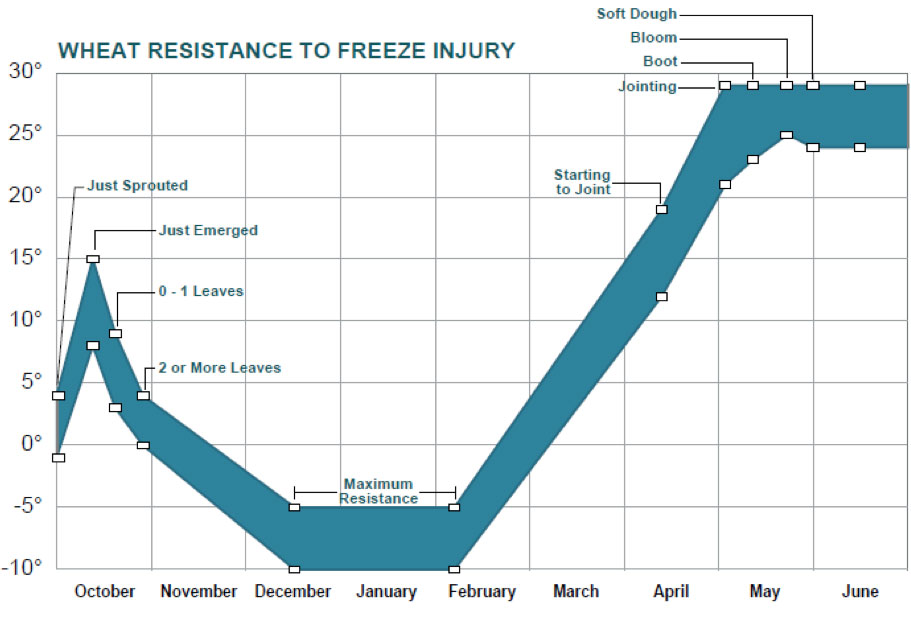Taking an environmentally sensitive approach to pest management
Understanding Wheat Growth Stages for Estimating Wheat Freeze Injury
Published: March 9, 2017
The very warm February stimulated wheat growth beyond what is typical for early to mid-March. It has reminded many of the 2007 warm late winter, and the infamous Easter freeze on April 7th of that year. It is likely we could see freezing temperatures several more times this late winter and early spring. Very cold temperatures March 11th and 12th throughout Missouri, and advanced wheat growth, has created some concern over the impact on the wheat crop. In 2007, the April 7th freeze caused significant impact on the wheat crop, however, Missouri wheat fields tended to respond better than expectations in most cases. There are many factors to consider and the extent of damage to the wheat crop depends on the growth stage, temperature, and duration of the low temperature. A big unknown is the weather after the freeze, which in 2007 turned out to be very favorable for recovery. To better understand what we can expect, the best guide to help assess the impact of freezing temperatures to wheat is an excellent publication entitled Spring Freeze Injury to Kansas Wheat. This reference has been used for many years to better understand the influence of growth stage on cold temperature tolerance in wheat.
Link to Kansas Wheat Freeze publication: http://www.bookstore.ksre.ksu.edu/pubs/c646.pdf
Figure 1: Temperatures that cause freeze injury to winter wheat at different growth stages. Winter wheat rapidly loses hardiness during spring growth and is easily injured by late freezes. (graph adapted from A.W. Pauli)

Figure 2: Temperatures that cause freeze injury to wheat at spring growth stages and symptoms and yield effect of spring freeze injury.
| Growth stage | Appx. injurious temp. (2 hrs.) | Primary symptoms | Yield effect |
|---|---|---|---|
| Tilering | 12 F (-11 C) | Leaf chlorosis; burning of leaf tips; silage odor; blue cast to fields | slight to moderate |
| Jointing | 24 F (-4 C) | Death of growing point; leaf yellowing or burning; lesions, splitting, or bending of lower stem; odor | Moderate to severe |
| Boot | 28 F (-2 C) | Floret sterility; spike trapped in boot; damage to lower stem; leaf discoloration; odor | Moderate to severe |
| Heading | 30 F (-1 C) | Floret sterility; white awns or white spikes; damage to lower stem; leaf discoloration | Severe |
| Flowering | 30 F (-1 C) | Floret sterility; white awns or white spikes; damage to lower stem; leaf discoloration | Severe |
| Milk | 28 F (-2 C) | White awns or white spikes; damage to lower stem; leaf discoloration; shrunken, roughened, or discolored kernels | Moderate to severe |
| Dough | 28 F (-2 C) | Shriveled, discolored kernels; poor germination | slight to moderate |
Wheat growth stage varies in Missouri from late tillering to jointing stages. (figure 3). If your wheat is in the tillering stage (the wheat is still relatively short and has prostrate growth) that crop can withstand temperatures down to about 12°F for two hours (figure 2). If the wheat is standing upright (pseudostem erection) and just prior to joint (no detectable node), the temperature that injury occurs is two hours at about 20°F. If you are able to detect a node, the temperature where injury occurs is at about 24°F for two hours. Cold injury at jointing can cause moderate to significant yield loss. Wheat is most sensitive to freezing temperatures at the heading and flowering stage. At heading and flowering, two hours at 30°F can result in severe yield loss due to sterility. Flowering begins near the center of the wheat spike (Feekes 10.5.1) followed by the top (Feekes 10.5.2), and bottom (Feekes 10.5.3) of the spike. Depending on the flowering stage, sterility may only occur on part of the spike.
The extent of injury will not be fully evident until temperature warm up and growth resumes. It is best to wait at least one week to assess the crop and the full extent of the damage becomes apparent.Figure 3: Feekes Growth Stage Chart. (Oklahoma State University)

Subscribe to receive similar articles sent directly to your inbox!
REVISED: March 9, 2017